The fast approach of autumn can be conflicting for many. Some might prefer to cling to the last few months of sweet summer warmth. Others may welcome the turning of leaves and donning of cozy sweaters with open arms. But there is one thing we can all appreciate about chilly fall weather: the disappearance of yellowjackets. However, the absence of these often-feared insects raises a warranted question. Where do they go?
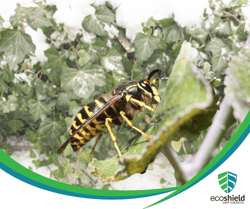
What are yellowjackets?
Before diving into yellowjackets’ mysterious disappearance in response to the changing of seasons, it’s helpful to understand yellowjackets as a species. Yellowjackets are a type of predatory wasp belonging to the Vespidae family. They are well-known for their distinct black and yellow coloration, which often leads to confusion with bees. However, yellowjackets are more closely related to other wasps, like hornets, than they are to bees.
These social insects are found in various parts of the world, including North America, Europe, and Asia. Yellowjackets typically live in colonies that consist of workers, males (drones), and a single reproductive female known as the queen. They are known for their aggressive nature, especially when their nests are disturbed, and they can deliver painful stings if provoked.
Yellowjackets are opportunistic predators, preying on various insects, spiders, and other small creatures. They are also attracted to sugary foods and can become a nuisance at outdoor picnics, barbecues, and other events where sweet foods or drinks are present. It’s for this reason that yellowjackets are commonly encountered near areas of human activity, like outdoor barbecues or picnics.
During the warmer months, yellowjackets are active and play a role in controlling other insect populations. However, as the weather turns colder and winter approaches, their behavior changes and they seem to disappear entirely.
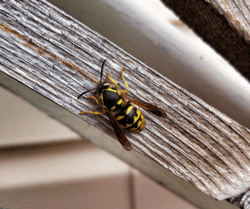 Yellowjackets are well-known for their distinct black and yellow coloration.
Yellowjackets are well-known for their distinct black and yellow coloration.
What happens to yellowjackets when it gets cold out?
When the temperatures drop and cold weather sets in, yellowjackets undergo several adaptations and behaviors to ensure their survival through the winter months. Here's what typically happens to yellowjackets when it gets cold out:
- Decreased Activity: As temperatures cool, yellowjacket activity decreases significantly. They become less active and spend more time inside their nests, conserving energy.
- Foraging Changes: Yellowjackets' primary food source is insects, spiders, and other arthropods, but as these become scarce in colder weather, they shift their diet to sugary substances like nectar and fruit juices. This change in diet helps sustain them during the leaner winter months.
- Nest Abandonment: In colder regions, yellowjacket colonies don't survive the winter as a whole. As fall approaches, the colony's workers, males, and older queens die off. Only newly mated queens enter a state of hibernation to survive until the following spring.
- Hibernation: The newly mated queens seek out protected areas to hibernate during the winter. Common hibernation sites include crevices in trees, under bark, in leaf litter, and even in human-made structures like attics and sheds. The queens enter a state of dormancy, lowering their metabolic rate and conserving energy.
- Cold Tolerance: Yellowjacket queens have developed a remarkable ability to tolerate cold temperatures. They can withstand freezing conditions by producing specific "antifreeze" proteins that prevent ice crystals from forming within their bodies.
- Emergence: When spring arrives, and temperatures rise, the hibernating queens awaken from their dormant state. They begin searching for suitable nesting sites and start new colonies. Once a suitable location is found, the queen constructs a small paper nest and begins laying eggs. As the colony grows, new workers hatch and take over the foraging and care of the developing brood.
It's important to note that the behaviors of yellowjackets can vary depending on the species and geographical location. In some warmer regions, yellowjacket colonies can persist throughout the year, with decreased activity during colder periods but no complete nest abandonment.
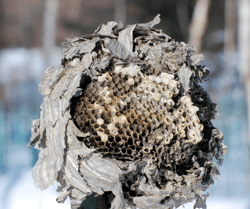 In colder regions, most yellowjacket colonies die off and abandon their nest.
In colder regions, most yellowjacket colonies die off and abandon their nest.
Do yellowjackets die off in freezing temperatures?
Yellowjackets, like many other insects, are susceptible to the effects of freezing temperatures. Most of the yellowjacket colony, including the workers and males, do not have adaptations to survive through the winter in freezing conditions. As colder temperatures set in, the workers and males in the colony typically die off. Even the queen, however resilient, can potentially die in extreme circumstances.
While queen yellowjackets are much more cold-hardy than other members of the colony, they can still die due to extreme cold conditions. Though queen yellowjackets have adaptations that allow them to tolerate freezing temperatures and enter a state of dormancy or hibernation to survive the winter, there are limits to their cold tolerance.
If the temperatures become too severe or if the queen is exposed to prolonged freezing conditions without adequate shelter, she may not be able to survive. Factors such as the duration of cold exposure, the availability of suitable hibernation sites, and the overall health and condition of the queen can all influence her ability to survive through the winter.
It's worth noting that while queen yellowjackets are better equipped to handle cold temperatures than other colony members, they are not immune to cold-related stressors. Their survival relies on finding well-protected hibernation sites and producing antifreeze proteins to prevent internal ice formation. In cases of exceptionally harsh winters or unfavorable circumstances, queen yellowjackets can perish due to the cold.
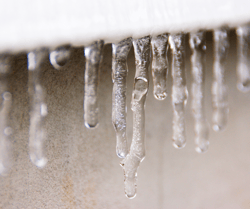 Though queen yellowjackets have adaptations that allow them to tolerate freezing temperatures, there are limits to their cold tolerance.
Though queen yellowjackets have adaptations that allow them to tolerate freezing temperatures, there are limits to their cold tolerance.
Can yellowjackets survive the fall and winter in warmer regions?
While colder regions may experience the majority of yellowjacket colonies dying off as temperatures drop, the same cannot be said for more temperate geographic locations. In regions with milder winters and relatively warmer temperatures, yellowjackets may exhibit different behaviors and adaptations than those in colder climates. Here's how yellowjackets can survive the fall and winter in warmer areas:
- Continued Colony Activity: In warmer regions, certain species of yellowjackets may be able to maintain their colonies throughout the fall and winter with reduced activity. While their activity levels may decrease due to cooler temperatures, these colonies can persist and carry on essential functions such as foraging, nest maintenance, and caring for the brood.
- Hibernation of Queens: Similar to colder climates, newly mated queens in warmer regions may also enter a state of hibernation or dormancy to survive the winter. These queens seek sheltered locations to conserve energy and endure the cooler months.
- Nest Location and Shelter: Yellowjacket colonies in warmer regions might select nest sites that offer better protection from temperature fluctuations. Choosing well-insulated locations, such as under eaves, inside wall voids, or other sheltered spots, can help the colony maintain a stable internal temperature, enhancing their chances of survival.
- Adaptations for Temperature Variation: Some species of yellowjackets in warmer areas might have adaptations that allow them to tolerate a wider range of temperatures. These adaptations could include changes in behavior, physiological adjustments, or nesting strategies that help them manage temperature fluctuations more effectively.
- Brood Care and Foraging: Even during the fall and winter months in warmer regions, yellowjacket colonies may continue to raise brood (developing larvae) and forage for food. While the pace of these activities might be slower than during warmer months, the colony can sustain itself through the winter without the need for complete hibernation.
Overall, yellowjackets in warmer geographic locations have the advantage of milder winters, allowing them to adapt their behaviors and strategies to maintain colony activity and ensure their survival through the fall and winter months. These adaptations reflect the flexibility of yellowjackets in adjusting to different climates and environments to thrive in a variety of conditions.
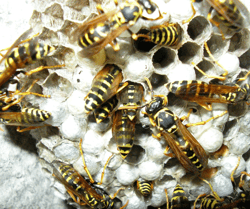 In warmer regions, certain species of yellowjackets may be able to maintain their colonies.
In warmer regions, certain species of yellowjackets may be able to maintain their colonies.
Can I be stung by a yellowjacket in the fall or winter?
While the risk of being stung by a yellowjacket in the fall and winter is lower compared to the warmer months, it is still possible under certain circumstances. Here are a few scenarios where you might encounter a yellowjacket and potentially get stung during the fall or winter:
- Late Fall Activity: In some cases, yellowjacket colonies may remain active into the late fall, especially in regions with milder climates. If you come across a yellowjacket nest that is still active, there's a possibility of being stung if the insects feel threatened or provoked.
- Disturbance of Hibernating Queens: Hibernating yellowjacket queens seek sheltered locations to spend the winter, such as under bark, in crevices, or even indoors. If you accidentally disturb a hibernating queen while moving or handling objects in your surroundings, she might feel threatened and sting in self-defense.
- Indoor Encounters: In some cases, yellowjackets may find their way indoors, seeking shelter from the cold. If you have a nest inside your home or other buildings, encountering an indoor yellowjacket during the fall or winter is possible.
- Outdoor Activities: While outdoor activities are generally less common in the fall and winter, there might still be instances where you come into contact with yellowjackets while cleaning up outdoor areas, gardening, or performing other tasks.
- Unusual Behavior: Some species of yellowjackets may exhibit more unusual behavior during the fall and winter, potentially leading to unexpected encounters. For instance, if a queen is disturbed from her hibernation site or if individual yellowjackets are searching for food sources in milder temperatures, you could encounter them and be stung.
It's important to approach any potentially active yellowjacket nests or individual insects with caution, regardless of the season.
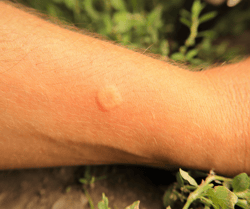 The risk of being stung by a yellowjacket in the fall and winter is lower compared to the warmer months, but still possible.
The risk of being stung by a yellowjacket in the fall and winter is lower compared to the warmer months, but still possible.
Which U.S. states may experience yellowjackets in the fall and winter?
Yellowjackets can be found in various parts of the United States, and their activity during the fall and winter can vary based on the local climate. While most yellowjacket colonies decline and become less active as the temperatures drop, some regions with milder winters may still see yellowjacket activity during the fall and early winter months. Here are a few U.S. states where yellowjackets might be encountered in the fall and winter:
- Southern States: States in the southern U.S., such as Florida, Texas, Louisiana, Georgia, and the Carolinas, have milder winters. Yellowjacket activity might continue into the fall and winter months in these regions. However, even in these states, yellowjacket activity tends to decrease during the colder months.
- Southwestern States: States like Arizona, New Mexico, and parts of Southern California have relatively mild winters, which might allow yellowjacket activity to persist into the fall and winter.
- Coastal States: Coastal regions of the United States, such as parts of California, Oregon, and Washington, might experience more moderate temperatures during the fall and winter, potentially allowing yellowjacket activity to continue to some extent.
- Hawaii: In Hawaii, where temperatures remain relatively consistent throughout the year, yellowjacket activity can occur year-round, including during the fall and winter.
It's important to note that even in the aforementioned regions, yellowjacket activity during the fall and winter is typically reduced compared to the warmer months. The majority of yellowjacket colonies in these areas will still experience a decline in activity, and their behavior will alter as they prepare for the winter months.
As always, if you encounter yellowjackets or their nests, we recommend that you exercise caution and avoid disturbing them, especially during the fall and winter when they might be more defensive due to their reduced numbers.
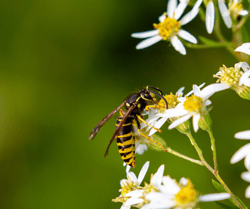 Some regions with milder winters may still see yellowjacket activity during the fall and early winter months.
Some regions with milder winters may still see yellowjacket activity during the fall and early winter months.
Can EcoShield Pest Solutions prevent and treat yellowjackets year-round?
Yes! EcoShield offers year-round protection against all stinging insects, including the notoriously aggressive yellowjacket. We highly recommend homeowners in warmer climates safeguard themselves and their families from yellowjackets all year, not just during the summer months. To prevent or treat yellowjackets in or around your home, give EcoShield a call or fill out the form on this page today.